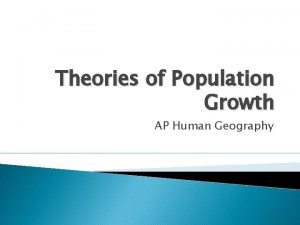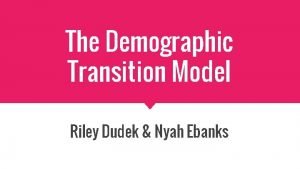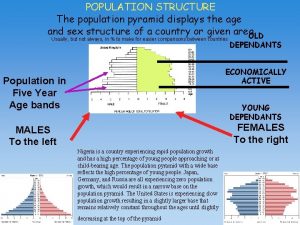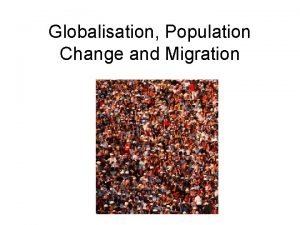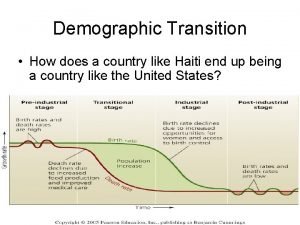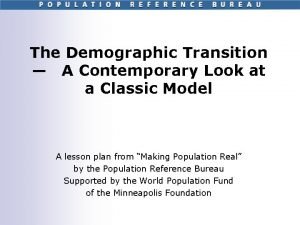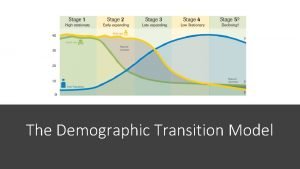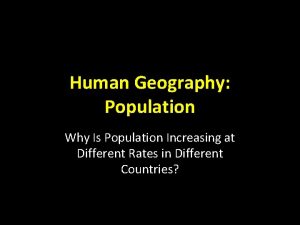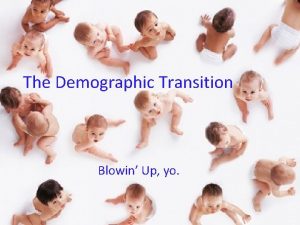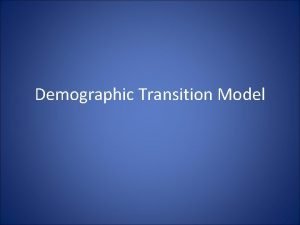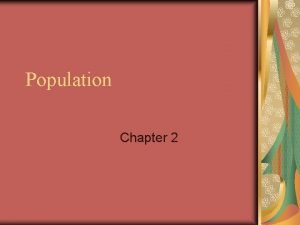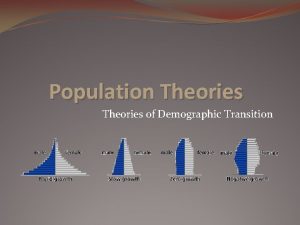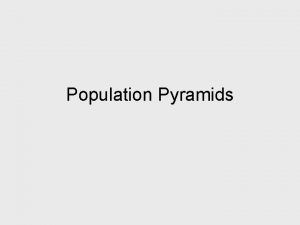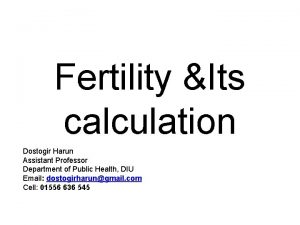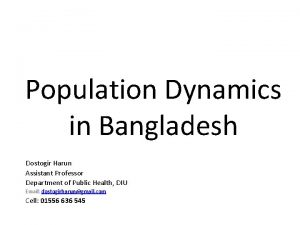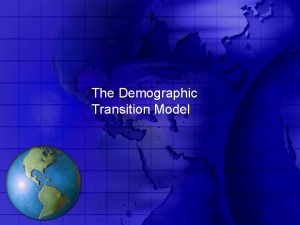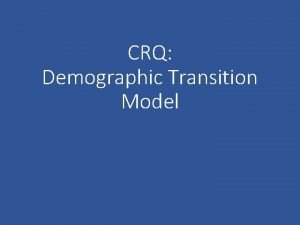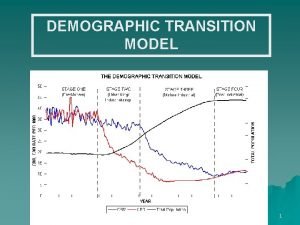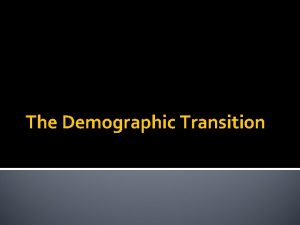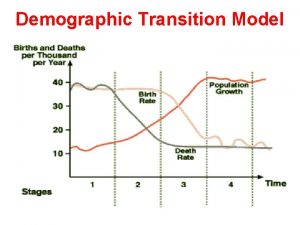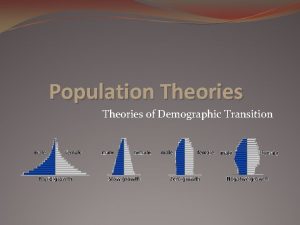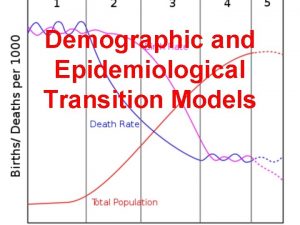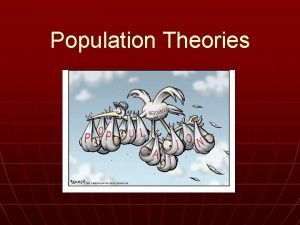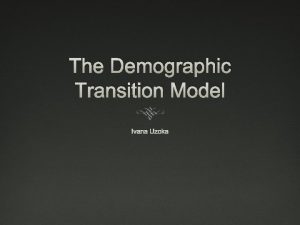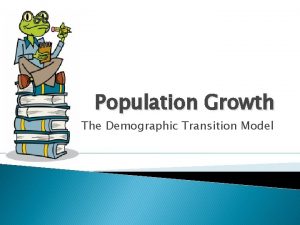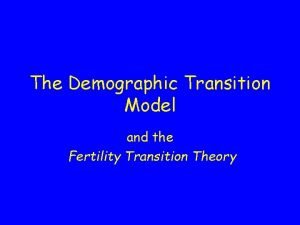Demographic transition Dostogir Harun Assistant Professor Department of































- Slides: 31

Demographic transition Dostogir Harun Assistant Professor Department of Public Health, DIU Email: dostogirharun@gmail. com Cell: 01556 636 545

Demographic transition • Demographic transition (DT) refers to the transition from high birth and death rates to low birth and death rates as a country develops from a pre-industrial to an industrialized economic system.

The demographic transition consists of several stages: • Pre-industrial stage: high death rates and high birth rates • Transitional stage: death rates fall due to rising food production and better medical care. Birth rates remain high, so population surges.

The demographic transition • Industrial stage: birth rates fall, as women are employed and as children become less economically useful in an urban setting. Population growth rate declines • Post-industrial stage: birth and death rates remain low and stable; society enjoys fruits of industrialization without threat of runaway population growth.

Demographic transition theory Demographic transition = model of economic and cultural change to explain declining death rates, declining birth rates, and rising life expectancies in Western nations as they became industrialized Proposed by F. Notestein in the 1940 s-1950 s

Demographic Transition Model • The Demographic Transition Model (DTM) shows how birth and death rates change as country goes through different stages of development. • The theory is based on an interpretation of demographic history developed in 1929 by the American demographer Warren Thompson (1887– 1973) • The model has five stages

Demographic transition model • How countries pass through different stages of population growth as shown in the five stages of the Demographic Transition Model (birth rate, death rate and natural population changes) and how it changes population structure • The impact of increasing urbanisation, agricultural change, education and the emancipation of women on the rate of population growth • A lot of countries have similar patterns of population change over time so they devised the Demographic Transition Model. • Demographic- is to do with population or people • Transition- means change • A model is a simplified version of something that happens in real life • The model has worked quite well for countries that have gone from a rural, poorly educated society to an urban, industrial, well-educated one. So it fits what happened in the UK, the rest of Europe, and other richer countries like Japan and the USA. But poorer countries might not follow the same pattern.

Demographic transition: Stages

A Proven Solution: Female Education Female literacy and school enrollment are correlated with total fertility rate: **More education fewer children

Family planning and Fertility Rate Nations that invested in family planning (green) reduced TFRs more than similar nations that did not (red)

HIV/AIDS and human population AIDS cases are increasing rapidly worldwide

QUESTION: Interpreting Graphs and Data What happens during the “transitional stage” of the demographic transition? a. Birth rates rise; death rates drop; population increases b. Birth rates drop; death rates drop; population decreases c. Death rates drop; birth rates are stable; population increases

Limiting Factors • Limiting Factor: anything that restricts the growth of a population in a biological community • Density-Dependent: relies on the number of people • Ex. Food/famine, clean water, shelter, build up of trash/toxic waste, pollution, plague/disease, stress, war, etc. • Density-Independent: unrelated to the number of people • Ex. Weather, climate, natural disasters, etc.

The “IPAT” model Shows how Population, Affluence, and Technology interact to create Impact on our environment. • I = P A T Further factors can be added to the original equation of Holdren and Ehrlich to make it more comprehensive.

Challenges • Rapid population growth in region wise and it is rising by 80 million annually • Large number of people are born into poverty • Rich and poor nations are divided by a “wealth gap. ” • Few diseases such as HIV/AIDS, Malaria, TB are taking a heavy toll, especially in Developing countries • Population growth has severe environmental effects and climate change

Solutions • Expanding women’s education rights is crucial to encourage the demographic transition • Health and reproductive education and counseling can reduce fertility rates • Education, vaccine, and policies can lessen the toll of Malaria, TB and HIV/AIDS • Environmental up gradation and “green” technologies can help reduce population growth’s environmental impacts & increase our carrying capacity

QUESTION: Review Women who are more educated tend to… ? a. Have higher TFRs. b. Live in developing nations c. Have fewer children d. Contract HIV/AIDS.

Demographic transition: Stages The demographic transition consists of several stages: Pre-industrial stage: high death rates and high birth rates Transitional stage: death rates fall due to rising food production and better medical care. Birth rates remain high, so population surges. Industrial stage: birth rates fall, as women are employed and as children become less economically useful in an urban setting. Population growth rate declines. Post-industrial stage: birth and death rates remain low and stable; society enjoys fruits of industrialization without threat of runaway population growth.

Stage 1: Pre-industrial stage • At stage 1 the birth and death rates are both high. • So the population remains low and stable. • Rural communities of Bangladesh would be at this stage. • High death rates would be attributed to poor water supply, poor health care, a reliance upon subsistence farming, disease and pests and an unreliable economy. • High birth rates would be attributed to a lack of knowledge of family planning, the need to have large families to help with work, and the women’s traditional role as a mother in these societies.

Stage 2: Transitional stage • At this stage death rate falls but the birth rate remains high. • Natural increase is greater so the population begins to grow rapidly. • Example of a country at this stage would be Sri Lanka or Peru. • The death rates often fall due to medical breakthroughs and new hospital services opening • Improvements may have also been made to accommodation or food and water supply. • Birth rates remain high for religious or cultural purposes and people are still not educated to using contraception.

Stage 3 • Birth rates now fall and death rates continue to fall. • Natural increase remains high and population growth is rapid. • An example of a country at this stage would be Chile or China. • The birth rates fall as there is better access to family planning and people have begun to appreciate the fact that families are expensive and that women are able to work. • Death rates continue to fall as medical care, water supply and accommodation are improved. •

Stage 4 • Birth rates and death rates level out. • The population now stabilises as the natural increase is low. • An example of a country at this stage is Australia. • Birth rates are low as the society is advanced and therefore, women choose for careers and smaller families to ensure that they have a better quality of life. • Death rates remain low

Stage 5 • The model was designed to only incorporate four stages, however, in recent years there has been call for a fifth stage to be added to the model. • At this stage the birth rate falls below the death rate and this result in a negative population increase. • An example of a country at this stage is Italy. • Italian women are deciding that a career is more important than a family and many decide to not have children at all by being sterilised. • Death rates remain low and the population begins

Limitations However, as with all theoretical models, the DTM does have its limitations and the model has failed to predict several occurrences. • Firstly, the model failed to predict the falling birth rates in many MEDC countries. • Secondly, the model assumes that all countries will pass through the same four stages, however, countries in Africa, for example, will never become industrialised. • And finally, countries such as Australia, USA and Canada, never went through the first stages as their populations grew due to emigration.

The Effects of the Demographic Transition on Economic Growth Implications for Japan- Marie-Lor Sundman • Abstract: • Demographic transition implies severe challenges for high income nations, for instance Japan, as the population decreases due to declines in birth rates as well as the higher rate of elderly population • More women are entering the labor market which affects birth rates. In addition, technological progress has improved health care and standard of living, bringing up life expectancies • However, the elderly population is increasing, elevating the dependency ratio which dampens the economic growth. The changed age structure alters the ratio of labor force negatively relative to population, in spite of the higher female labor participation

The Effects of the Demographic Transition on Economic Growth Implications for Japan- Marie-Lor Sundman • This paper analyzes how the current demographic transition in advanced countries influences economic growth • The paper is focused on Japan that is currently dealing with the consequences from the fastest increase in the percentage share of the elderly population compared to the other high income countries • The empirical analysis is based on a growth accounting model that estimates the impact of demographic factors on growth rates in high income countries • The empirical results indicate that demographic factors such as life expectancy and total dependency ratio have a negative impact on economic growth

Demographic Transitions and Economic Miracles in Emerging Asia-David E. Bloom • Abstract • The demographic transition—a change from high to low rates of mortality and fertility—has been more dramatic in East Asia during the twentieth century than in any other region or historical period • By introducing demographic variables into an empirical model of economic growth, this article shows that this transition has contributed substantially to East Asia's so-called economic miracle • The miracle occurred in part because East Asia's demographic transition resulted in its working-age population growing at a much faster rate than its dependent population during 1965– 90, thereby expanding the per capita productive capacity of East Asian economies.

Demographic Transitions and Economic Miracles in Emerging Asia-David E. Bloom • This effect was not inevitable; rather, it occurred because East Asian countries had social, economic, and political institutions and policies that allowed them to realize the growth potential created by the transition • The empirical analyses indicate that population growth has a purely transitional effect on economic growth; this effect operates only when the dependent and working-age populations are growing at different rates • These results imply that future demographic change will tend to depress growth rates in East Asia, while it will promote more rapid economic growth in Southeast and South Asia.

Key learning • Demographic transition theory suggests that populations grow along a predictable five-stage model • In stage 1, pre-industrial society, death rates and birth rates are high and roughly in balance, and population growth is typically very slow and constrained by the available food supply. • In stage 2, that of a developing country, the death rates drop rapidly due to improvements in food supply and sanitation, which increase life spans and reduce disease.

Key learning • In stage 3, birth rates fall due to access to contraception, increases in wages, urbanization, increase in the status and education of women, and increase in investment in education. Population growth begins to level off • In stage 4, birth rates and death rates are both low. The large group born during stage two ages and creates an economic burden on the shrinking working population • In stage 5 (only some theorists acknowledge this stage— others recognize only four), fertility rates transition to either below-replacement or above-replacement.

Thanks!
 Ptt 444
Ptt 444 Harun dogo
Harun dogo Demographic transition model uk
Demographic transition model uk Demographic transition theory by warren thompson
Demographic transition theory by warren thompson Demographic transition model ap human geography
Demographic transition model ap human geography Demographic transition model example
Demographic transition model example Population pyramid stage 1
Population pyramid stage 1 Demographic transition theory
Demographic transition theory Demographic transition
Demographic transition Haiti demographic transition model
Haiti demographic transition model Demographic transition model
Demographic transition model Uk demographic transition model
Uk demographic transition model Two big breaks in the demographic transition
Two big breaks in the demographic transition Demographic transition model worksheet
Demographic transition model worksheet Demographic transition model ap human geography
Demographic transition model ap human geography Afghanistan demographic transition model
Afghanistan demographic transition model Demographic transition theory
Demographic transition theory Dtm model
Dtm model Demographic transition model song
Demographic transition model song Denmark demographic transition model
Denmark demographic transition model Demographic transition def
Demographic transition def Ap human geography models and theories
Ap human geography models and theories Theory of demographic transition
Theory of demographic transition Promotion from associate professor to professor
Promotion from associate professor to professor Cuhk assistant professor salary
Cuhk assistant professor salary The country with the narrowest population pyramid is
The country with the narrowest population pyramid is Kathy lau
Kathy lau Demographic data definition
Demographic data definition Geographic demographic and psychographic
Geographic demographic and psychographic Demographic momentum ap human geography definition
Demographic momentum ap human geography definition Demographic dimensions of consumer market
Demographic dimensions of consumer market Pringles target audience
Pringles target audience




